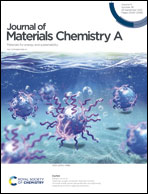Rose-like, ruthenium-modified cobalt nitride nanoflowers grown in situ on an MXene matrix for efficient and stable water electrolysis†‡
Abstract
Exploring bifunctional electrocatalysts with high efficiency, low cost, and durability is of great importance for water electrolysis but still remains a great challenge and needs to be thoroughly studied. In this work, rose-like, ruthenium-doped cobalt nitride nanoflowers grown in situ on Ti3C2Tx MXene are synthesized through a simple oil bath method followed by nitridation treatment under an NH3 atmosphere. Benefiting from good conductivity and an optimized electronic structure, the resultant Ru–CoN/Ti3C2Tx MXene exhibits remarkable and stable bifunctional electrocatalytic activities towards both the hydrogen evolution reaction (HER) and the oxygen evolution reaction (OER) in 1.0 M KOH solution. More importantly, a two-electrode electrolyzer constructed with the Ru–CoN/Ti3C2Tx MXene only needs a low cell voltage of 1.52 V to deliver a current density of 10 mA cm−2, outperforming the benchmark RuO2‖Pt/C couple and most recently reported representative bifunctional electrocatalysts. This work provides a new strategy for the rational design and fabrication of efficient and nonprecious catalysts for water electrocatalysis and other electrochemical energy systems.



 Please wait while we load your content...
Please wait while we load your content...